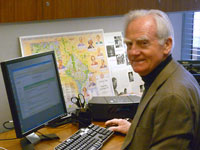Temple of the Muses
One man’s quest to create a museum of American writing
By Nicholas A. Basbanes  Nicholas A. Basbanes recently received a National Endowment for the Humanities fellowship to work on his book on paper, which is forthcoming from Knopf. His most recent book is Editions & Impressions, a collection of essays. His other works include the acclaimed A Gentle Madness, Every Book Its Reader, Patience & Fortitude, Among the Gently Mad, and A Splendor of Letters.
Nicholas A. Basbanes recently received a National Endowment for the Humanities fellowship to work on his book on paper, which is forthcoming from Knopf. His most recent book is Editions & Impressions, a collection of essays. His other works include the acclaimed A Gentle Madness, Every Book Its Reader, Patience & Fortitude, Among the Gently Mad, and A Splendor of Letters.
An ambitious effort to establish an American Writers Museum is observing its first anniversary this month, with widespread support for the bold undertaking growing by the day, and plans already afoot to mount a traveling exhibition that will focus on the impact immigrant authors have had on our remarkable literary heritage.
Among several important milestones recorded over the past year, one of the more consequential, according to Dr. Malcolm O’Hagan of Washington, D.C., founding president of the American Writers Museum Foundation, was the formal recognition the group received from the Internal Revenue Service as a 501(c) (3) nonprofit organization, qualifying all gifts as one hundred percent tax deductible donations. Hard on the heels of that was the submission in January of an application to the National Endowment for the Humanities for a grant to support the proposed exhibition, tentatively titled “Finding Home: Immigrant Voices in American Literature.”
Institutions that have already offered to host the inaugural effort include the New York Public Library, the Newberry Library in Chicago, the Huntington Library in San Marino, California, and the Harry Ransom Humanities Research Center at the University of Texas, Austin. In addition to providing space for the show, each of the institutions would augment the traveling exhibit with materials from their own research collections, giving each venue a decidedly regional appeal.
“It’s a good start,” O’Hagan agreed, although raising the $200 million from private sources he feels is necessary to underwrite the museum and insure its long-term viability remains the greatest challenge of all. “Yes, that’s a scary figure, I agree, but not by museum standards,” he said. “If you do it right—and I think literature deserves its own cathedral in this country—then it’s going to cost a lot of money. The whole idea is to honor literature in the history and culture of our nation. To realize the vision of a new building, and to establish a continuing endowment, then that’s the threshold. Our goal is to bring our writers and our literature into the public discourse of the nation.”
O’Hagan’s vision begins with the realization that no such museum exists anywhere in the United States, an especially egregious omission, he feels, considering the richness, depth, and diversity of American literature. “Look at the hundreds of millions of dollars that have been contributed to museums, and not a penny has gone to literature,” he said. “Who has had a greater influence on our culture? The words of Jefferson and Lincoln? The words of Martin Luther King, Jr.? These are the words that resonate with people, and yet we don’t have an institution that recognizes that, and elevates it.”
Although nobody has compiled a precise inventory, the American Association of Museums estimates there are 17,500 museums of varying sizes in this country celebrating everything from the natural sciences, the fine arts, automobiles and railroads to baseball, rock and roll, seafaring, and aviation. There are remarkable libraries and research collections, to be sure, many of which mount magnificent exhibitions of books, manuscripts, and archives that include selections from their own vast holdings, but no museum in the traditional sense—a temple of the muses, literally—to inspire and educate the general public on the history, culture, and influence of the great literary canon that is our shared inheritance.








